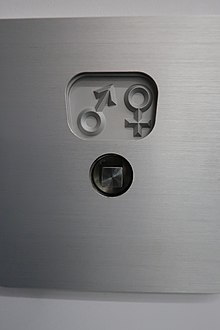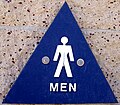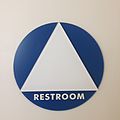Gender symbol

Agender symbolis apictogramorglyphused to representsexandgender,for example in biology and medicine, ingenealogy,or in the sociological fields ofgender politics,LGBT subcultureandidentity politics.
In his booksMantissa Plantarum(1767) andMantissa Plantarum Altera(1771),Carl Linnaeusregularly used theplanetary symbolsof Mars, Venus and Mercury –♂,♀,☿– for male, female and hermaphroditic (perfect) flowers, respectively.[1]Botanists now use⚥for the last.[2]
In genealogy, including kinship in anthropology and pedigrees in animal husbandry, the geometric shapes△or□are used for male and○for female. These are also used onpublic toiletsin some countries.
The modern internationalpictogramsused to indicate male and female public toilets,🚹︎and🚺︎,became widely used in the 1960s and 1970s. They are sometimes abstracted to▽for male and△for female.[3]
Biology and medicine
[edit]| ♀♂⚥ △□○ | |
|---|---|
Gender symbol | |
| InUnicode | U+2640♀FEMALE SIGNU+2642♂MALE SIGN
U+26A5⚥MALE AND FEMALE SIGNU+25B3△WHITE UP-POINTING TRIANGLE U+25A1□WHITE SQUAREU+25CB○WHITE CIRCLE |
The three standard sex symbols in biology are male♂,female♀and hermaphroditic⚥;originally the symbol for Mercury,☿,was used for the last. These symbols were first used byCarl Linnaeusin 1751 to denote whether flowers were male (stamensonly), female (pistilonly) orperfect flowerswith both pistils and stamens.[1](Most flowering and conifer plant species are hermaphroditic and either bear flowers/cones that themselves are hermaphroditic, or bear both male and female flowers/cones on the same plant.) These symbols are now ubiquitous in biology and medicine to indicate the sex of an individual, for example of a patient.[4][a]
Genealogy
[edit]
Kinship chartsuse a triangle△for male and circle○for female.[6][7]Pedigree chartspublished in scientific papers use an earlier anthropological convention of a square□for male and a circle○for female.[8]
Before a shape distinction was adopted, all individuals had been represented by a circle in Morgan's 1871System of Consanguinity and Affinity of Human Family,where gender is encoded in the abbreviations for the kin relation (e.g. M for 'mother' and F for 'father').[9]W. H. R. Riversdistinguished gender in the words of the language being recorded by writing male kinship terms in all capitals and female kinship terms with normal capitalization. That convention was quite influential for a time, and his convention of prioritizing male kin by placing them to the left and females to the right continues to this day though there have been exceptions, such asMargaret Mead,who placed females to the left.[10]
Linguistics
[edit]Inlinguistics,a 'grammatical gender' system is a specific form of anoun classsystem, where nouns are assigned to gender categories that are often not related to the real-world qualities of the entities denoted by those nouns. Inlanguages with grammatical gender,most or all nouns inherently carry one value of thegrammatical categorycalledgender,typically 'masculine', 'feminine', and 'neuter'. In addition toU+2640♀FEMALE SIGNandU+2642♂MALE SIGN,Unicode encodes a symbol for theneuter gender,U+26B2⚲NEUTER.
Public toilets
[edit]
The modern gender symbols used forpublic toilets,🚹︎for male and🚺︎for female, are pictograms created for theBritish Railsystem in the mid-1960s.[11]Before that, local usage had been more variable. For example, schoolhouseouthousesin the 19th-century United States had ventilation holes in their doors that were shaped like a starburst Sun✴or like a crescent Moon☾,respectively, to indicate whether the toilet was for use by boys or girls.[12]The British Rail pictograms – often color-coded blue and red[citation needed]– are now the norm for marking public toilets in much of the world, with the female symbol distinguished by a triangular skirt or dress, and in early years (and sometimes still) the male symbol stylized like atuxedo.[3]
These symbols are abstracted to varying degrees in different countries – for example, the circle-and-triangle variants![]() (female) and
(female) and![]() (male) commonly found onportable toilets,to the extreme of a triangle△(representing a skirt or dress) for female and an inverted triangle▽(representing a broad-shouldered tuxedo) for male in Lithuania.[3]
(male) commonly found onportable toilets,to the extreme of a triangle△(representing a skirt or dress) for female and an inverted triangle▽(representing a broad-shouldered tuxedo) for male in Lithuania.[3]
In elementary schools, the pictograms may be of children rather than of adults, with the girl distinguished by her hair. In themed locations, such as bars and tourist attractions, a thematic image or figurine of a man and woman or boy and girl may be used.[citation needed]
In Poland, an inverted triangle▽is used for male while a circle○is used for female.[3]
In mainland China, silhouettes of heads in profile may be used as gender pictograms,[citation needed]generally alongside the Chinese characters for male (Nam) and female (Nữ).[13]
Some contemporary designs for restroom signage in public spaces are shifting away from symbols that demonstrate gender as binary as a way to be more inclusive.[14][15]
-
StandardAmerican Institute of Graphic Arts(AIGA) symbols
-
Non-AIGA women's symbol on a legally mandated circular background in US
-
Non-AIGA men's symbol on a legally mandated triangular background in US
-
Gender-neutral sign in US, composed of legally mandated circle and triangle
-
Accessiblegender-neutral sign icon
-
Idiosyncratic unisex restroom in US (seeLGBT symbols)
-
Public toilet in China, with female silhouette to the left and male to the right
-
Idiosyncratic symbols in Japan
-
Humorous symbols in Austria
-
Semi-triangular tuxedo and dress shapes in Hungary
-
Triangle-plus-circle symbols in Austria
-
Circle (female) and inverted triangle (male) in Poland
-
Sign in Romania, with men's and women's shoes representing gender
-
Male, female andhijra(trans) public toilets in India
-
Signs in theReal Jardín Botánico de Madrid;the male is depicted with a largeupper bodyand the female with widehips
Sexual orientation and gender politics
[edit]
Since the 1970s, variations of gender symbols have been used to expresssexual orientationandgender politics.Two interlocking male symbols (⚣) are used to representgay menwhile two interlocking female symbols (⚢) are often used to representlesbians.[16]Two female and two male symbols interlocked representbisexuality,while an interlocked female and male symbol (⚤) representsheterosexuality.[17]
The combined male-female symbol (⚦) is used to representandrogyneortransgenderpeople; when additionally combined with the female (♀) and male (♂) symbols (⚧) it indicates gender inclusivity[citation needed],though it is also used as a transgender symbol.[18][19]
The Mercury symbol (☿) and combined female/male symbol (⚥) have both been used to representintersexpeople.[20][17]A featureless circle (⚪︎), neuter symbol (⚲), and the Alchemical Symbol (🜬) are used to represent bothasexualityandnon-binarypeople.[21][17]
Since the 2000s, numerous variants of gender symbols have been introduced in the context ofLGBTculture and politics.[17]Some of these symbols have been adopted intoUnicode(in theMiscellaneous Symbolsblock) beginning with version 4.1 in 2005.
Encoding
[edit]| Unicode Standardname | Symbol | Additional remark in standard[22][23] | |
|---|---|---|---|
| U+2640♀FEMALE SIGN | ♀ | ||
| U+2642♂MALE SIGN | ♂ | ||
| U+26A5⚥MALE AND FEMALE SIGN | ⚥ | Intersex, androgynous; hermaphrodite (in botany) | |
| U+25B3△WHITE UP-POINTING TRIANGLE | △ | Trine | |
| U+25BD▽WHITE DOWN-POINTING TRIANGLE | ▽ | Hamilton operator | |
| U+25A1□WHITE SQUARE | □ | ||
| U+25CB○WHITE CIRCLE | ○ | ||
| U+1F7D5🟕CIRCLED TRIANGLE | 🟕 | ||
| U+1F6B9🚹MENS SYMBOL | 🚹︎ | Man symbol; men'srestroom | |
| U+1F6BA🚺WOMENS SYMBOL | 🚺︎ | Woman symbol; women's restroom | |
| U+1F6C9🛉BOYS SYMBOL | 🛉︎ | ||
| U+1F6CA🛊GIRLS SYMBOL | 🛊︎ | ||
| U+1F6BB🚻RESTROOM | 🚻︎ | Man and woman symbol with divider; unisex restroom[b] | |
See also
[edit]- Alchemical symbol
- Astrological symbols
- Fertility symbols
- LGBT symbols
- Miscellaneous SymbolsUnicode block
- Sex symbol– Person or character widely regarded as sexually attractive
Notes
[edit]- ^In the biological sense of the word, there are no human (or mammalian) hermaphrodites, but 'hermaphodite' has long been used for ambisexual people who are now more commonly labeledintersex.[5]
- ^This symbol is often seen on an outer door leading to separate facilities behind inner doors, in which case the glyph has a dividing line separating the men and women symbols
References
[edit]- ^abStearn, William T. (May 1962). "The Origin of the Male and Female Symbols of Biology".Taxon.11(4): 109–113.doi:10.2307/1217734.JSTOR1217734.S2CID87030547.
- ^Niki Simpson,Botanical symbols: a new symbol set for new images,Botanical Journal of the Linnean Society,Volume 162, Issue 2, February 2010, Pages 117–129
- ^abcdGlancey, Jonathan (11 September 2014)."The genius behind the stick figure toilet signs".BBC Future.
In Poland, meanwhile, you can come across lavatories indicating 'gents' with a triangle and 'ladies' with a circle, while in Lithuania men are represented by an inverted pyramid and women by a pyramid standing the right way up. [...] One of the best early examples of intuitive global signs for public lavatories was that created for British Rail in the mid-1960s. [...] In the 1970s, the British example was developed on a more comprehensive basis in the United States. In 1974, the US Department of Transportation commissioned the American Institute of Graphic Arts to create a set of pictograms to be used throughout public transport networks whether road, rail, air or sea.
- ^Han, Zhigang; et al. (25 September 2009)."A HIV-1 heterosexual transmission chain in Guangzhou, China: a molecular epidemiological study".Virology Journal.6(148). BioMed Central: Figure 1.doi:10.1186/1743-422X-6-148.PMC2761389.PMID19778458.
(Mars male gender symbol) indicates male; (female Venus gender symbol) indicates female
- ^Alice Domurat Dreger (1998)Hermaphrodites and the Medical Invention of Sex
- ^"Kin Diagrams".umanitoba.ca.Retrieved2019-12-02.
- ^"Kin Diagrams".umanitoba.ca.Retrieved2019-12-02.
- ^Schott, G D (24 Dec 2005)."Sex symbols ancient and modern: their origins and iconography on the pedigree".BMJ.331(7531). British Medical Journal: 1509–1510.doi:10.1136/bmj.331.7531.1509.PMC1322246.PMID16373733.
- ^Morgan, Lewis Henry (1870).Systems of consanguinity and affinity of the human family.University of California Libraries. [Washington, Smithsonian Institution.
- ^Wilson, Ara (2018-07-24)."Visual Kinship".History of Anthropology Review.Retrieved2019-12-02.
- ^Glancey, Jonathan (11 September 2014)."The genius behind stick figure toilet signs".BBC.
Classics of design:One of the best early examples of intuitive global signs for public lavatories was that created for British Rail in the mid-1960s. As part of a major modernisation programme, the state railway was given a new and all-embracing corporate identity by DRU [Design Research Unit], a design studio founded by Marcus Brumwell and Misha Black in 1943. Working with Margaret Calvert and Jock Kinneir, who designed a distinctive Rail Alphabet typeface based on Helvetica, DRU devised a clean-cut and convincingly modern aesthetic that was applied to all locomotives, trains, stations, published material and, yes, signs for lavatories.
(includes picture of the ideogram, which is copyright). - ^Eric Sloane (1972, 2007)The Little Red Schoolhouse: A Sketchbook of Early American Education.Doubleday & Co.; Dover Books.
- ^Summers, Josh (2020-11-19)."Chinese Toilet | What to Expect (including Squat Toilets)".Travel China Cheaper.Retrieved2023-06-02.
- ^Schwartz, M. (2018). Inclusive Restroom Design.Library Journal,143(8), 28–31.
- ^Dobson, Terry (Winter 2017)."Tip of the Icon: Examining Socially Symbolic Indexical Signage".Dialectic.I(1).doi:10.3998/dialectic.14932326.0001.106.ISSN2572-7001.
- ^"Symbolism".LGBTQA+ WebCenter.Eastern Illinois University. Archived fromthe originalon 12 February 2016.Retrieved31 December2015.
Since the 1970s, gays have used double interlocking male symbols to represent gay men. Double interlocking female symbols are often been used [sic] to symbolize lesbianism, but some feminists have instead used the double female symbols to represent sisterhood among women and three interlocking female symbols to denote lesbianism.
- ^abcdMcElroy, D.R. (2020).Signs & Symbols of the World: Over 1,001 Visual Signs Explained.London, United Kingdom: The Quarto Group.ISBN9781577151869.
- ^"Transgender Symbol".GenderTalk.July 1994.
- ^"History of Transgender Symbolism".International Transgender Historical Society (ITHS).2015. Archived fromthe originalon 2021-06-01.Retrieved2018-11-13.
- ^Eigtved, Martin LeBlanc."Mercury, hermaphrodite, intersex, gender, sex, gender identity, sexuality icon".Iconfinder.
- ^"Unicode Asexuality Character".Sexual Diversity.6 November 2022.
- ^"Miscellaneous Symbols | Gender symbols"(PDF).Unicode Consortium.Retrieved2020-06-28.
- ^"Transport and Map Symbols – Range: 1F680–1F6FF – 1F6B9"(PDF).Unicode Consortium.Retrieved2020-07-01.















